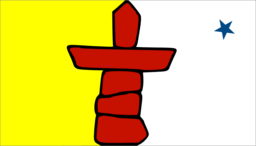Inukshuk
|
|

An inukshuk (Inuktitut: inuksuk / ᐃᓄᒃᓱᒃ, plural inuksuit / ᐃᓄᒃᓱᐃᑦ) is a stone landmark used as a milestone or directional marker by the Inuit of the Canadian Arctic. Inuksuit differ from cairns in significance. The Arctic Circle, dominated by permafrost, has few natural landmarks and thus the inukshuk was central to navigation across the barren tundra.
Inuksuit vary in shape and size, and perform a diverse array of tasks. The word inuksuk means something which acts for or performs the function of a human. It is a symbol with deep roots in the Inuit culture, a directional marker that signifies safety, hope and friendship.
An inukshuk is shown on the flag and Coat of Arms of the Canadian territory of Nunavut, and the flag of Nunatsiavut. An inukshuk is also shown on the cover of the Rush album Test for Echo.
A structure similar to an inukshuk but meant to represent a human figure, called an inunguak ("imitation of a person"), has become widely familiar to non-Inuit. However, it is not the most common type of inukshuk and is distinguished from inuksuit in general. An inunguak forms the basis of the logo of the 2010 Winter Olympics; its use in this context has been controversial, both among Inuit and among the First Nations of British Columbia. [1] (http://www.cbc.ca/story/canada/national/2005/04/26/Olympiclogo0426.html)
Vancouver_2010_final.jpg
Compare
External link
- Places of Power - essay and photographs of inuksuit (http://www.civilization.ca/archeo/inuksuit/inuk00e.html)
